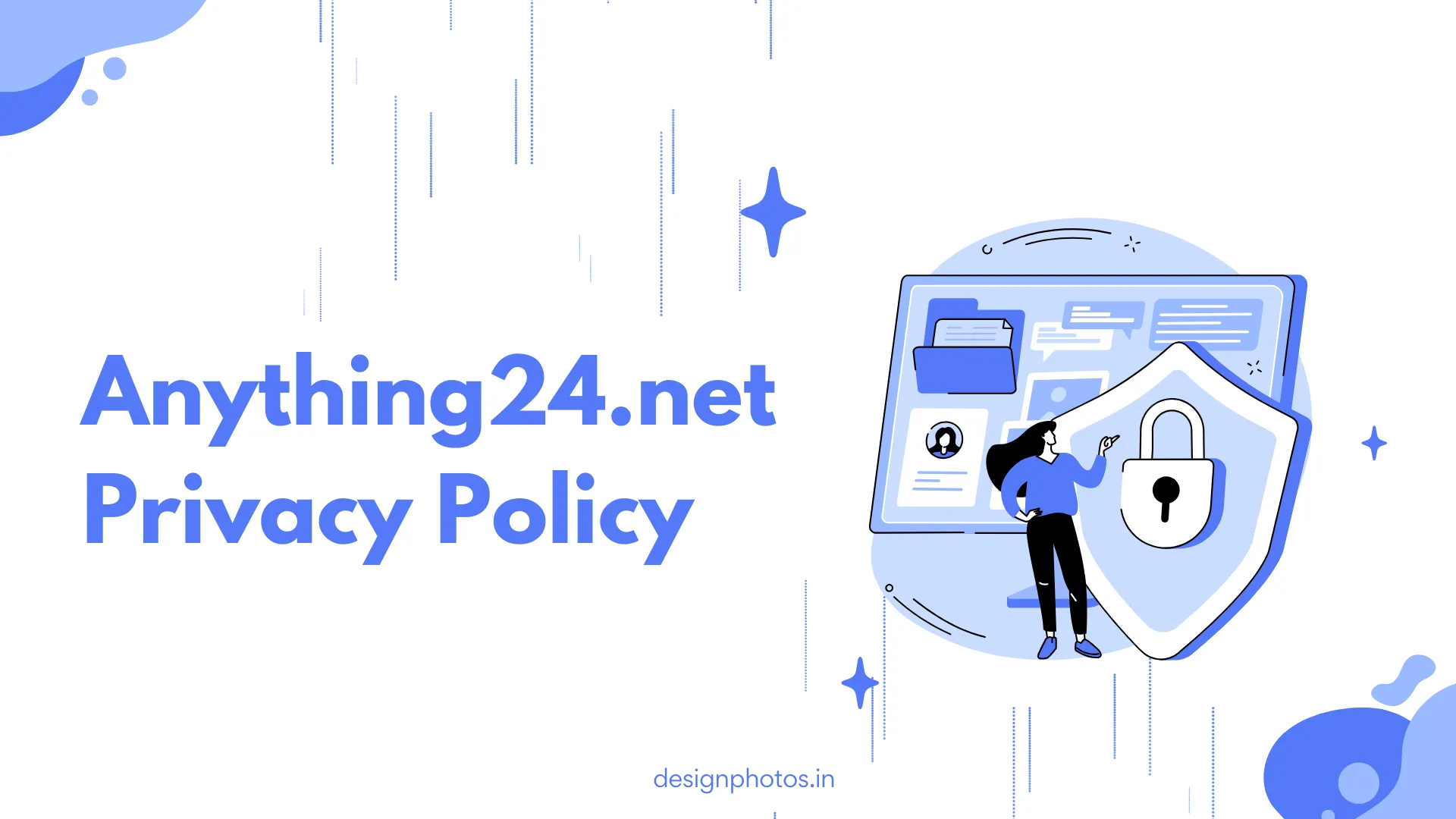A privacy policy is more than just legal text—it is a declaration of how personal information is collected, used, shared, secured, and retained. For websites like Anything24.net, which publish content across categories and may enable interactions such as comments, contact forms, or newsletters, a robust privacy policy establishes trust and transparency. It explains what data is gathered (such as names, emails, IP addresses, and analytics data), how long it is kept, where it might be shared, and what rights users have to access, correct, or delete their information. A clear policy also helps align with global privacy laws such as the GDPR and the CCPA, especially if the website serves audiences in multiple jurisdictions. Readers benefit by understanding what happens to their data behind the scenes and how they can exercise control over it.
What Is Anything24.net and How It Influences Data Practices
Anything24.net appears to operate as a content platform, publishing articles across topics like health, technology, lifestyle, and motivation. This breadth of content and potential features—such as comment sections, email subscriptions, contact forms, and embedded media—shapes the categories of data the site might process. A blog with user interactions typically handles identifiers submitted through forms, device and usage data captured via analytics, and cookie-based preferences to maintain session functionality. If the site uses third-party services for performance, analytics, spam protection, monetization, or content delivery networks, the privacy policy should identify those providers and disclose the data implications. The way content is organized and the tools used to deliver it directly inform what the policy must disclose about collection, storage, sharing, and user rights.
Also Read – Wixnets.com: SEO, Speed, and Growth in One Platform
How Anything24.net Likely Collects Information
A comprehensive privacy policy typically outlines several collection methods. First, there is information provided directly by users, such as when submitting a comment, signing up for a newsletter, filling out a contact form, or requesting support. These entries usually include names, email addresses, and the message content. Second, the site likely collects technical and usage data automatically, including IP addresses, browser type, device information, pages viewed, timestamps, referral URLs, and session metadata. This data is often gathered through server logs and analytics scripts and is used to understand engagement and performance. Third, cookie-based data helps the site remember preferences and enable secure sessions. Cookies may be strictly necessary for site function, while others support performance, analytics, or personalization. Finally, there can be third‑party sources—such as embedded content, anti‑spam tools, or newsletter services—that supplement collection and require explicit disclosure in the policy.
The Types of Data Typically Covered
A well-structured policy groups data into clear categories. Personal identifiers often include name, email, and potentially profile image or avatar if comments are enabled. Contact and communication data reflects the content of messages sent via forms. Technical and usage data includes device identifiers, IP addresses, geolocation approximations derived from IP, event timestamps, and navigation patterns. Cookie and tracking data comprises information about session persistence, preference handling, and analytics events across sessions. If monetization is involved—such as display advertising or affiliate links—the policy should call out advertising identifiers and explain any ad personalization settings. Where applicable, sensitive categories are explicitly disclaimed or supported with added safeguards, noting that such information should not be submitted unless specifically requested for a legitimate purpose.
How Anything24.net Uses the Collected Information
The policy should explain the core purposes of processing in plain language. Common purposes include delivering and maintaining the website, personalizing the reading experience, preventing fraudulent or abusive activity, and communicating with readers about updates or responses to inquiries. Analytics are typically used to understand what content resonates, improve editorial planning, and resolve performance issues. If newsletters are offered, the policy should clarify how email addresses are used, how consent is obtained, and how to unsubscribe at any time. Security-related uses include monitoring for spam, bot activity, and unauthorized access attempts. If personalization features exist, the policy should distinguish between necessary processing for function and optional processing for recommendations or personalized ads, providing clear opt-out pathways where appropriate.
Cookies, Tracking Technologies, and Preferences
Cookies and similar technologies are a core part of modern websites. A privacy policy should explain the categories and functions of cookies, such as strictly necessary cookies for secure login or basic functionality, performance cookies for load balancing and speed, analytics cookies for understanding engagement, and preference cookies for remembering display or language choices. If third‑party analytics like Google Analytics are used, the policy should name the provider, describe what data is shared (e.g., IP addresses or pseudonymous identifiers), and link to the provider’s own policy. Where the site supports a cookie banner or preference center, the policy should explain how to modify consent settings, including how to disable certain categories without breaking essential features. Instructions for browser-level controls and links to opt-out tools should be provided to support user choice.
Data Sharing: Service Providers and Legal Requirements
Responsible websites rely on trusted service providers for hosting, analytics, email delivery, security, and content delivery networks. The policy should state that personal information is shared with vendors only to the extent necessary to provide services and under appropriate contractual safeguards. The policy should also address disclosures required by law, such as responding to lawful requests by public authorities or enforcing site terms. If the site participates in advertising networks or affiliate programs, it should clarify how identifiers may be shared or accessed by third parties and offer options to opt out of personalized ads where relevant. The policy should emphasize that data is not sold in the colloquial sense unless the site explicitly engages in a “sale” under privacy regulations, in which case a clear opt-out mechanism must be included.
International Transfers and Regional Compliance
If Anything24.net uses service providers or infrastructure outside a user’s country or region, the policy should address international data transfers. For audiences in the European Economic Area, the policy should identify a lawful basis for processing—such as consent, legitimate interests, contract necessity, or legal obligation—and reference appropriate transfer safeguards like standard contractual clauses. For California residents, a CCPA/CPRA section should define categories of personal information, whether data is “sold” or “shared” for cross‑context behavioral advertising, and provide opt-out links. Additional regional rights, such as those in the UK, Brazil, Canada, or India, should be acknowledged if the audience is global. Where minors may interact with the site, the policy must address parental consent and restrictions on processing children’s data in line with applicable laws.
Data Retention and Deletion Practices
A transparent privacy policy specifies how long different categories of data are retained. For example, server logs might be kept for a limited period to ensure security and troubleshoot issues. Analytics data could be retained for trend analysis with defined aggregation or anonymization timelines. Contact form submissions might be stored as long as needed to address the inquiry, followed by deletion or archival under strict controls. Comment data may persist unless removed by the user or moderated by the site. A data retention section should explain the criteria used to set retention periods, such as legal obligations, dispute resolution needs, or operational necessity. It should also outline how to request deletion or de‑identification, noting that certain data may be retained if required by law or needed for security purposes.
Security Measures and Risk Management
Security is an ongoing process, and the policy should emphasize both technical and organizational measures taken to protect personal information. Typical controls include encryption in transit, hardened hosting environments, access controls limiting who can handle data, and routine monitoring for suspicious activity. The policy may also discuss vendor due diligence and incident response practices without revealing sensitive system details. It is important to clarify that no method is completely secure, set expectations for breach notifications where legally required, and provide guidance to readers—such as avoiding posting sensitive personal information in public comments and using strong, unique passwords wherever accounts are supported.
User Rights: Access, Correction, and Objection
Modern privacy frameworks center user rights. The policy should explain how to request access to personal information, correct inaccuracies, request deletion, restrict or object to processing, and obtain a copy of data in a portable format when applicable. It should detail the identity verification process to prevent unauthorized requests. For consent-based processing—like certain analytics or email subscriptions—the policy should state that consent can be withdrawn at any time without affecting prior lawful processing. It should further clarify how to lodge complaints with supervisory authorities, such as a data protection regulator, and how to escalate unresolved concerns with the site’s privacy contact.
Also Read – AdvantageBizMarketing.com: Freelancing, Blogging, Branding
Consent, Legal Bases, and Legitimate Interests
If the site serves EU or UK users, the policy should map processing purposes to lawful bases. Consent is appropriate for optional features like marketing emails or non-essential cookies. Contract necessity might cover core features requested by the user, such as delivering content or responding to inquiries. Legal obligations cover retention required by tax or regulatory laws. Legitimate interests, when used, should be balanced and justified—such as preventing fraud, ensuring network security, or improving site performance—while offering opt-out methods when feasible. Clear articulation of legal bases helps readers understand why data is processed and how rights attach to each purpose.
Children’s Privacy and Age Limits
A responsible policy addresses whether the site is intended for children and how minors’ data is treated. If Anything24.net is not directed to children, the policy should state an age threshold (often 13 or 16, depending on jurisdiction) and describe steps taken if underage submissions are discovered. When relevant, it should detail parental consent mechanisms and restricted data practices for younger users. Even if the site is general‑audience content, this clarity reduces risk and ensures compliance with laws like COPPA in the United States and similar regulations elsewhere.
Third‑Party Links and Embedded Content
Content websites frequently link to or embed third‑party services—videos, social posts, or external articles. The policy should clarify that third‑party sites and embedded services operate under their own privacy terms and may collect data via their widgets or cookies. Readers should be advised to review those policies separately, as Anything24.net cannot control how external parties handle data. When possible, the site should limit passive data exposure through privacy‑enhancing embed options, such as “no-cookie” modes for video platforms or lazy loading that reduces automatic third‑party calls.
How to Exercise Rights and Contact the Site
A practical policy provides clear contact channels: a dedicated privacy email address, a web form, or a postal address for formal requests. It should specify what to include in a request, such as the nature of the request (access, correction, deletion), relevant identifiers, and any verification documents required. Expected timelines should be given—for instance, a response within one month for GDPR‑covered requests or within statutory periods for other jurisdictions. If the site uses a Data Protection Officer or representative for certain regions, that contact should be listed. Clarity on process, timing, and verification reduces friction and builds trust.
Policy Updates and Version Control
Websites evolve, and privacy policies should evolve with them. The policy should indicate an “Effective Date” and explain how changes will be communicated, such as posting an updated version on the site, adding a notice banner, or emailing subscribers for material updates. It should clarify when changes take effect and how continued use of the site relates to acceptance. Maintaining an archive or a brief change log helps readers understand what has changed and why, especially when new features or vendors are introduced.
Practical Tips for Readers to Stay in Control
Readers can take simple steps to manage data exposure while enjoying content. Adjusting cookie preferences via the site’s consent tool, disabling non‑essential analytics, or using browser tracking protection can reduce third‑party data sharing. Subscribing to newsletters with an address dedicated to subscriptions and promptly using unsubscribe links keeps inboxes and personal profiles cleaner. When commenting publicly, avoiding sensitive personal details prevents unintended exposure. Finally, periodically exercising access or deletion rights ensures that data held by the site aligns with a reader’s current preferences.
A Model Structure for Anything24.net Privacy Policy
An effective privacy policy for Anything24.net can follow a clear structure that readers can scan quickly while still providing legal completeness. A suggested structure includes: Introduction and Scope; Information Collected (Direct, Automatic, Cookies, Third‑Parties); Purposes of Processing; Legal Bases (where applicable); Data Sharing and International Transfers; Data Retention; Security Measures; User Rights and How to Exercise Them; Children’s Privacy; Third‑Party Links and Embeds; Changes to This Policy; and Contact Information. Each section should be concise, written in plain language, and cross‑referenced where needed. If the site offers region‑specific notices, appends for EU/UK, California, or other regions can be added for clarity and compliance.
Aligning With Best Practices and Regulations
To keep pace with evolving standards, Anything24.net should periodically conduct a data mapping exercise, confirm vendor compliance, and review cookie inventories for accuracy. Implementing a consent management platform with granular choices supports modern expectations and regulatory requirements. Documenting data protection impact assessments for higher‑risk processing and establishing incident response procedures further hardens compliance. By coupling transparent disclosures with disciplined operational controls, the site can demonstrate accountability and maintain reader trust over the long term.
Conclusion
Privacy is fundamentally about respecting people and their expectations. A clear, comprehensive, and regularly updated privacy policy signals that Anything24.net treats personal data responsibly and welcomes reader engagement on privacy questions. By explaining data practices plainly, offering meaningful choices, and honoring rights promptly, the site can foster a relationship grounded in transparency. That trust allows the content to shine, encourages responsible community participation, and ensures that legal compliance is not just a checkbox but a cornerstone of the platform’s ethos.
FAQs
What information does Anything24.net collect?
Anything24.net typically collects information provided directly in forms (such as names, emails, and messages), as well as technical and usage data captured automatically (including IP address, device/browser details, pages viewed, timestamps, and referral URLs). If comments, newsletters, analytics, or anti‑spam tools are enabled, the site may also process cookie identifiers and engagement events necessary for functionality, security, and performance.
How does Anything24.net use my data?
Data is generally used to operate and secure the website, respond to inquiries, personalize content, analyze engagement for improvement, prevent spam or fraud, and communicate about updates or subscriptions. If email newsletters are offered, addresses are used to deliver those communications, with opt‑out available at any time via unsubscribe links or stated preferences.
Does Anything24.net share or sell personal information?
Personal data may be shared with trusted service providers—such as hosting, analytics, email delivery, security, and content delivery networks—only to the extent needed to provide services and under appropriate safeguards. The site’s privacy policy should clarify whether data is “sold” or “shared” as defined by applicable laws and provide an opt‑out where required; otherwise, the policy typically indicates that personal data is not sold in the conventional sense.
How can I control cookies, analytics, or marketing preferences?
Cookie banners or preference centers, when present, allow managing non‑essential cookies like analytics and advertising. Browser settings can also restrict cookies and tracking, though this may affect site functionality. If email subscriptions exist, preferences can be changed or unsubscribed at any time using provided controls, and requests to opt out of certain processing can be sent via the site’s stated contact method.
Does the anything24.net privacy policy explain how long data is retained?
Yes. The anything24.net privacy policy should specify how long different types of data are kept, the criteria used to determine retention (such as legal obligations, security needs, or service provision), and when information is deleted or anonymized once it is no longer necessary. It should also outline how to request deletion and note any exceptions where retention is required for compliance or dispute resolution.



